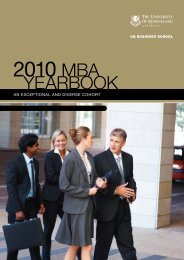Modelling the accruals process and assessing unexpected accruals*
Modelling the accruals process and assessing unexpected accruals*
Modelling the accruals process and assessing unexpected accruals*
You also want an ePaper? Increase the reach of your titles
YUMPU automatically turns print PDFs into web optimized ePapers that Google loves.
flow associated with income recognised in <strong>the</strong> past, current or future periods (C). 3 In short, NOA<br />
is increased by OI <strong>and</strong> reduced by free cash flow.<br />
NFO identity: NFE is comprehensive financing expense (net of financing income). NFO includes<br />
loans, income tax liabilities, preference shares, investments on marketable securities, <strong>and</strong><br />
minority interests. It is increased by financing expenses incurred but reduced by actual payment<br />
of financing expenses <strong>and</strong> principal repayments.<br />
CSE identity: CNI is comprehensive income. This identity can also be obtained if one combines<br />
cash, NOA, <strong>and</strong> NFO identities. It asserts that owner‟s equity in a firm is increased by income<br />
<strong>and</strong> reduced by net distributions to shareholders.<br />
2.2 Accrual calculation <strong>and</strong> <strong>the</strong> reconciliation between indirect <strong>and</strong> direct methods<br />
The key difference between accrual <strong>and</strong> cash basis accounting lies in <strong>the</strong>ir timing of recognition<br />
(Statement of Financial Accounting Concepts, No. 6 Paragraph 144). Cash accounting<br />
recognizes a transaction when <strong>the</strong> associated cash flow is realized ra<strong>the</strong>r than expected. As a<br />
result, <strong>the</strong> change in net operating assets in <strong>the</strong> NOA identity <strong>and</strong> <strong>the</strong> change in net financial<br />
t<br />
obligation in NFO identity Table 1 are both zero under cash accounting (i.e., NOA 0<strong>and</strong> t<br />
NFO 0 ), where <strong>the</strong> subscript c denotes cash accounting. 4 This associated with <strong>the</strong> basic<br />
c<br />
3 According to Dechow <strong>and</strong> Dichev (2002), Ct consists of<br />
t<br />
t 1 t<br />
t 1<br />
, C , <strong>and</strong><br />
t<br />
C t<br />
t<br />
t<br />
. C offsets <strong>the</strong> cash transactions<br />
t<br />
t 1<br />
recognized in OI. C t 1<br />
reduces NOA <br />
t 1<br />
when earnings recognized in <strong>the</strong> past are received. C , cash flows received<br />
for earnings to be recognized in future periods, will create operating liability that reduces NOA.<br />
4 This is because C=OIB, I = DA, <strong>and</strong> F=NFE under cash accounting.<br />
C <br />
t<br />
c<br />
9



